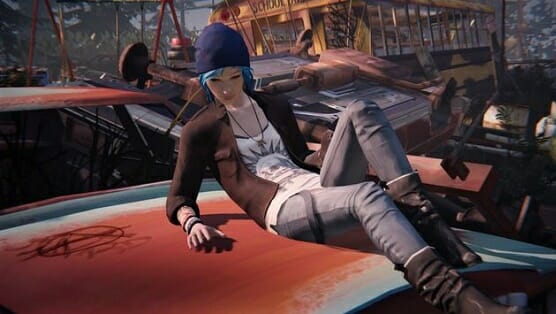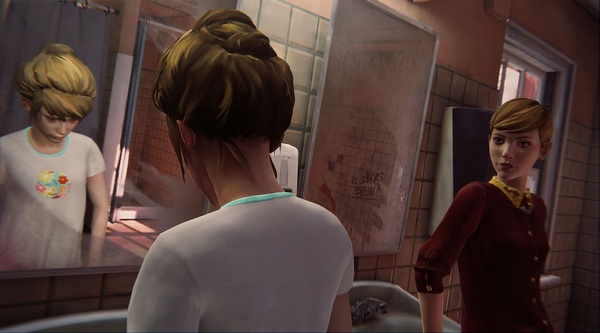
I’m worried about where Life Is Strange is headed.
The second episode of Dontnod Entertainment’s game about a teen who discovers she has time-travel powers may have bitten off more than it could chew. If Life Is Strange were a TV show, I would have removed it from my queue by now—but since it’s a videogame, I don’t have any other options to choose from if I want to experience a story about women (even one created by an all-male team, since that is the deal that the games industry has regretfully struck, at least until they figure out how to hire women).
This episode’s first hour echoes the promise of the first episode; Life Is Strange excels in the small details of environmental storytelling. Max starts her day with a shower and a text from Chloe, the childhood best friend who has rekindled their bond now that Max has moved back to their old hometown. Chloe implores Max not to be “late” to their breakfast date, but just like in Episode One, Max can’t ever be “too late” to anything—not because of her time travel powers, but because of the game’s structure. No matter how long Max spends in the shower eavesdropping on the popular girls, or having a heart-to-heart with her school friend Kate, or absentmindedly strumming the guitar leaned against her bedroom wall, she’ll still beat Chloe to the diner and order a meal with time to spare.
Why instruct the player over and over to “not be late,” then? For a game about time travel, Life Is Strange has a very opaque approach to how much time—and how much power—the player has over what’s happening in the world around them. In this episode, Max learns that if she uses her time travel too often, she’ll get a nosebleed and pass out from exhaustion; this essentially means that Max can use her ability as often as she needs to when the game calls for it, but if the narrative stakes would benefit from Max being unable to use her ability, she’ll suddenly be too tired to save the day in the usual way. There is no charge meter for Max’s ability, nor is there any ticking clock in-game. I understand the lack of these fixtures, since they would add an unnecessarily gamified layer to the tactile, virtual world of Life Is Strange—but the unfortunate result is that Max’s powers seem reliant upon the whims of the narrative.
The narrative takes some particularly thorny turns in Episode 2, and I’m not sure the writers of this game have proven themselves up to the task ahead of them. In Episode 1, Max narrowly saved Chloe from getting shot by Nathan Prescott, a fellow student who deals drugs, throws wild parties, and roofies the girls who attend them. His parents are rich enough to cover up their son’s horrific crimes; when Max tells her principal that Nathan brought a gun to school, the man hardly seems concerned. At the start of Episode 2, Kate tells Max that she believes Nathan tried to drug her at a party and sexually assault her; Chloe told a very similar story at the end of Episode 1. So, Nathan Prescott is a drug dealer, an attempted murderer (or just a straight-up murderer, if Max didn’t have the time travel powers to stop him), and a serial rapist. Honestly, do we need all three of these to prove Nathan’s a real villain? It’s no wonder that the authority figures think Max must be making up stories when she tries to turn this guy in.
The middle of this episode involves a long sequence in a junkyard with Chloe; she tells you to find bottles so that she can practice aiming at them with a gun she stole from her stepdad. Chloe implies that she intends to shoot Nathan with the gun once she gets good enough at practicing. This is around when the game’s mechanics begin to show their seams. Life Is Strange can’t seem to decide whether or not it needs “gamey” elements, like point-and-click puzzles and the absurd sequence in which Max uses her powers to help Chloe aim a gun. How and why would time travel help somebody aim a gun? Well, it doesn’t, and this sequence makes absolutely no sense at all. The junkyard scene includes multiple moments where you have to save Chloe’s life, yet again; playing with a gun is dangerous, plus Chloe has some dangerous friends who live near the junkyard, plus Chloe thinks it’s fun to play on the train tracks even though a train comes every few minutes or so.
I was willing to let Chloe’s death wish slide, yet again, since it appeared to be an implication that no matter how hard Max works to protect her friend, some fates may be inevitable. But this is a pretty dark theme to include when it comes to the rest of the story in Life Is Strange—you know, the part where Chloe and Max’s friend Kate have both had run-ins with a serial rapist, and they both blame themselves for the encounter? It also doesn’t help that when Max tries to help her friends, all of the authority figures in her life don’t believe her or them; Max’s super-cool photography teacher outright says that Kate brought this on herself, a sentiment so disgusting that I’m surprised the game would give that line to a character who has hitherto been painted as one of Max’s mentors. I sure hope we’re supposed to hate him now.
The conclusion of Episode 2 involves a character attempting suicide. That would be a “spoiler” for people who don’t always wish they had a warning about scenes like this, such as me. Unfortunately, I think Dontnod also bit off more than they could chew with these scene as well. Max has the opportunity to intervene in this character’s attempt and try to talk them off the ledge; the conversation lasts for about ten minutes, but the character’s final decision relies on whether Max happens to guess the right answer to one final question. This is not only a heart-wrenching way to approach the topic, but it’s also inaccurate; suicidal people often do reach out for help before making their attempt, and so an intervention in the moment can be life-saving. For example, all 29 people who survived suicide attempts from the Golden Gate Bridge have said that they regretted their choice as soon as they jumped. Max’s intervention shouldn’t have a randomized fail state at all; if she makes it to the intervention in the first place, she’s already done the hardest part of helping a suicidal friend. She just has to show up in time. And we know Max can do that much.
I’m worried about how heavy-handed this episode got after its first hour. I’m worried about how often Chloe ends up in trouble. Even though this game is about a woman, all of her female friends still seem to end up getting damseled … or dead. I’m worried that Life Is Strange was written by people who don’t really know how to write a story about teenage girls, and rape, and drugs, and parties, and bullying, and depression, and suicide. I’m worried that the problems I see in this episode are only going to become more pronounced as the game goes along. But I have so few options when it comes to games that even try to tackle these issues in the first place that I feel like I have to take what I can get, even when the result feels about as ham-fisted as a teen soap TV show. Life Is Strange has a few more episodes to prove me wrong—and as always, I sure hope they do. They still have time, but unlike Max’s, it’s running out.
Life is Strange Episode Two was developed by Dontnod Entertainment and published by Square Enix. We played it on PS4. It is also available for Playstation 3, Xbox One, Xbox 360 and PC.
Maddy Myers is Paste’s assistant games editor. She tweets @samusclone and co-hosts a weekly gaming podcast called Isometric on the 5by5 Network.
